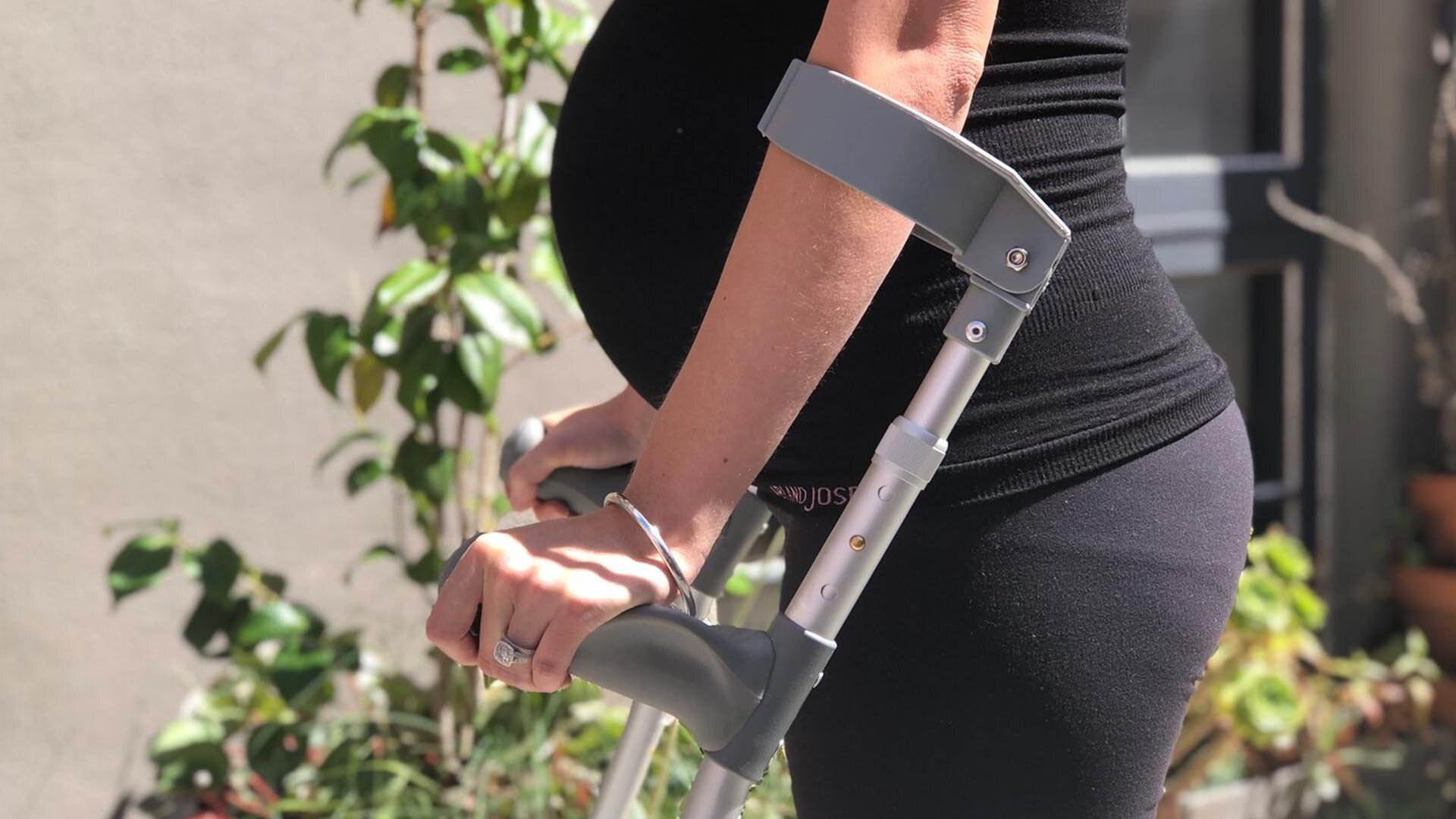Pelvic Girdle Pain in Pregnancy
Pelvic girdle pain (PGP) in pregnancy is a common condition, affecting around a quarter of women during their pregnancy.
PGP in pregnancy used to be known as symphysis pubis dysfunction (SPD) and has also been described by other terms including: sacroiliac joint (SIJ) dysfunction and pelvic instability.
The pelvic girdle is a ring of bones around your body at the base of your spine and connects your legs to your torso. PGP is pain felt in the front and/or back of your pelvis and can also be felt in other areas such as the buttocks, hips or thighs. While it is not harmful to the developing baby, PGP in pregnancy can cause severe pain around the pelvic area and make it difficult to move. At its worst, it can cause significant physical disability and has an important impact on the psychosocial wellbeing of pregnant women and their families. Early diagnosis is important and treatment to relieve pain is safe at any stage during or after pregnancy.
What might I experience?
Typically women experience pain with walking, climbing stairs, getting in and out of the car, turning over in bed, during sexual intercourse and when dressing. Women may also experience clicking or grinding in the pelvic area. Pain may be felt in the pubic region, lower back, hips, groin, buttocks, thighs or knees. The pain is usually described as a sharp, stabbing pain, or sometimes feeling like the legs can give way.
As the baby grows, the extra weight and change in posture will put more strain on the pelvis. Whilst PGP is more common later in pregnancy it can begin at any time, sometimes as early as during the first trimester, before any weight gain and before women are “showing”.
While pregnant women experience low back pain more commonly than PGP, it impacts more heavily on function, often inhibiting women from exercising, being generally active, and in some more severe cases, walking at all.
Why does PGP occur in pregnancy?
The current evidence suggests that the causes of PGP are multifactorial and not always clearly explained.
There are three joints in the pelvis that normally work together and are able to move small amounts. During pregnancy hormones are made that cause your ligaments to soften and stretch and allow more movement in your joints. The two main hormones that allow this to happen are relaxin and progesterone. It is a common misconception that these hormones lead to PGP in pregnancy however studies have not shown a direct association between these hormones and PGP.
It is established that these hormones allow the ligaments in the pelvis to loosen, or become lax, in preparation for birth. If there is asymmetry in how loose the ligaments are, the joints at the back and/or front of the pelvis move unevenly. This can lead to the pelvic girdle becoming less stable and less effective at transferring weight between the torso and legs. The combination of asymmetry and instability leads to pain.
Risk factors for developing PGP in pregnancy
a previous history of low back pain,
a previous history of PGP in pregnancy
a previous history of trauma.
Hypermobility syndrome
Note: a short interval between pregnancies is not a risk factor.
What can I do to manage my pain?
There are some simple things you can do to try and manage pain:
stay active with regular low impact exercise, within the limits of pain (see our article “exercise suggestions during pregnancy”)
rest sensibly (rest more frequently, or sit down for activities that normally involve standing e.g Ironing)
avoid walking on uneven surfaces like soft sand or on rocky paths
take smaller steps when walking
wear supportive, low-heeled footwear
stand tall with your bump and bottom tucked in a little and with your weight evenly distributed through both legs
change your position frequently – try not to sit for more than 30 minutes at a time
sit to get dressed and undressed
put equal weight on each leg when you stand
try to keep your legs together when getting in and out of the car
lie on the less painful side while sleeping
keep your knees together when turning over in bed
when getting in and out of bed, roll to your side and use your arms to push yourself up or lower yourself down
use a pillow under your bump and between your legs for extra support in bed
lift objects with your knees bent and keep your back straight
accept offers of help and involve partner, family and friends in daily chores (this is when you get to pass on the vacuuming!)
You should try to reduce or avoid any activities that may make your symptoms worse, such as:
lifting anything heavy, e.g. heavy bags
pushing shopping trolleys
going up and down stairs
stooping, bending or twisting to lift
sitting on the floor or sitting twisted
sitting or standing for long periods
standing on one leg
crossing your legs
reaching, pushing or pulling to one side
carrying anything on one hip e.g. baby or toddler
carrying bags on one side
moving or pushing things with your feet
running, jumping or hopping
wearing high-heeled shoes
breast stroke swimming
What about specific treatments?
If you have PGP in pregnancy or PGP persisting after giving birth, we recommend finding (or getting a referral to) a practitioner experienced in treating pelvic girdle pain so that you can be formally assessed and directed towards appropriate treatment.
Treatments may include:
exercises to help relieve your pain and allow you to move around more easily. These exercises generally work on strengthening specific muscles to balance asymmetries and improve stability
manual therapy. This is hands-on treatment to the muscles and joints to release area which are overloaded or tight. It is generally done by a physiotherapist or osteopath who specialises in PGP in pregnancy and will help to gently mobilise or move the joints.
warm baths, or heat or ice packs
hydrotherapy
acupuncture
Pelvic support belt or crutches. Note that if you need to use a support belt, remember to make sure it fits properly – don’t just borrow your friend’s belt without getting the fit checked first!
For most women, early diagnosis and treatment should help relieve pain, prevent symptoms getting worse and allow them to continue everyday activities. It is therefore important that you seek treatment early. PGP is not something you just have to ‘put up with’ until your baby is born.
REFERENCES:
WALTERS, C, WEST, S AND NIPPITA, TA. PELVIC GIRDLE PAIN IN PREGNANCY. AJGP. JULY 2018;47(7):439-443. DOI 10.31128/AJGP-01-18-4467
CLINTON SC, NEWELL A, DOWNEY PA, FERREIRA K. PELVIC GIRDLE PAIN IN THE ANTEPARTUM POPULATION. US: WOMEN’S HEALTH AMERICAN PHYSICAL THERAPY ASSOCIATION, 2017; P. 102–24
VLEEMING A, ALBERT HB, ÖSTGAARD HC, STURESSON B, STUGE B. EUROPEAN GUIDELINES FOR THE DIAGNOSIS AND TREATMENT OF PELVIC GIRDLE PAIN. EUR SPINE J 2008;17(6):794–819. DOI: 10.1007/S00586-008-0602-4.
PELVIC OBSTETRIC & GYNAECOLOGICAL PHYSIOTHERAPY. PREGNANCY-RELATED PELVIC GIRDLE PAIN (PGP) – FOR HEALTH PROFESSIONALS. UK: POGP, 2015; P. 1–10
DAMEN L, BUYRUK HM, GTILER-UYSAL F, SNIJDERS CJ, LOTGERING FK, STAM HJ. PELVIC PAIN DURING PREGNANCY IS ASSOCIATED WITH ASYMMETRIC LAXITY OF THE SACROILIAC JOINTS. ACTA OBSTET GYNECOL SCAND 2001; 80: 1019-24
AUTHORS:
AMY LAU, RHEA PSERECKIS
DISCLAIMER
THE CONTENT PROVIDED ON THIS WEBSITE IS FOR EDUCATION AND INFORMATION PURPOSES ONLY. IT IS NOT INTENDED TO REPLACE INDIVIDUAL HEALTH PROFESSIONAL CARE. READ OUR FULL DISCLAIMER HERE

